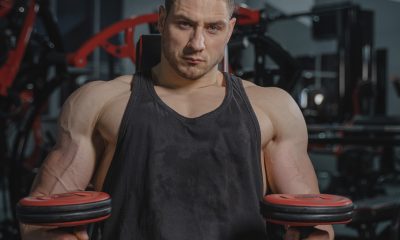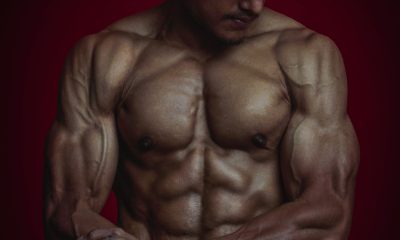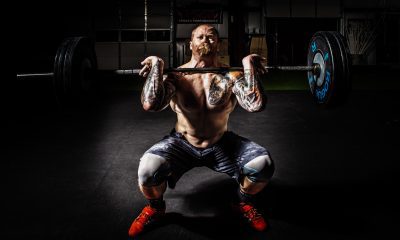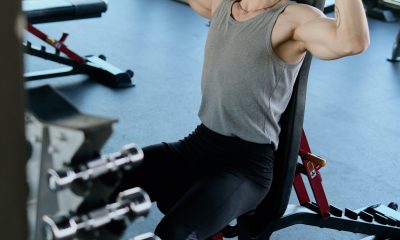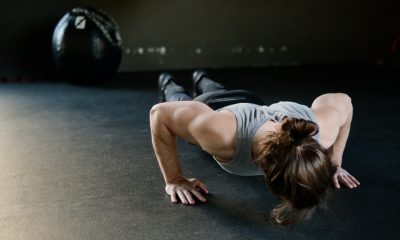Bodybuilding
How to Choose the Right Weights When Training
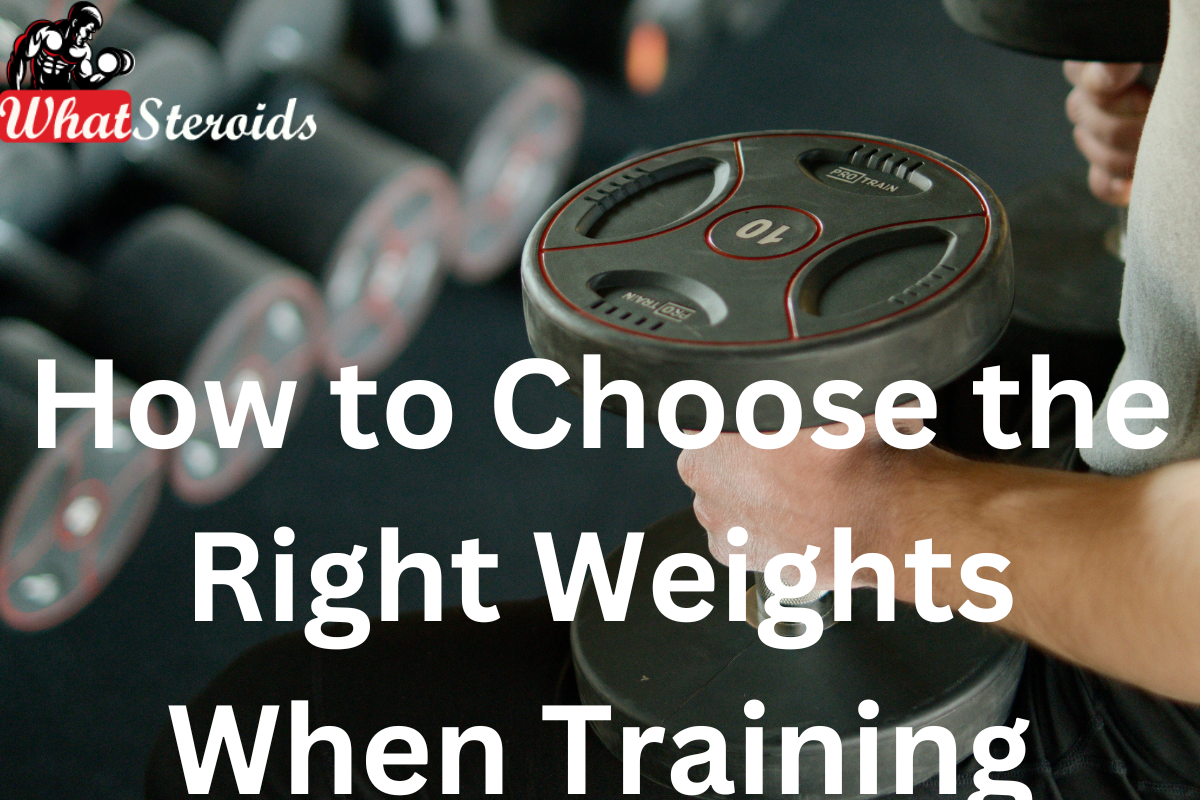
This is one of the most common questions that answer want to know all people who practice bodybuilding. Whether you are a novice and this problem keeps you from building an effective workout or are more experienced and looking for an optimum load to achieve the desired results, the weights used are essential in this sport.
But it would be more right to address the question in another way: what is your goal when using weights? Weights used for bodybuilding exercises vary depending on the intended purpose of doing exercise.
Those wishing to gain muscle will work heavily in contrast to those who want a definition of the muscles, so-called “muscle relief,” which follows a highlighting muscle group. In this case, it reduces weight but substantially increases the number of repetitions in each set.
Although exercise is the same, the number of repetitions and the weights used can get different results, so you need to know the track in training.
Weights for Growing Muscle Mass
Most bodybuilding exercises are designed to gain muscle mass. Therefore, in the places of practice of professional bodybuilders and weight lifting, you will see weights that you most likely cannot pick up. Most of the uninitiated people confuse bodybuilders with weightlifters. But as you, these areas of activity are different in purpose and way of training.
This picture, however, hides a truth: to become huge, covered by voluminous muscles, you must use big training weights, even very big, so you can properly execute a set number of repetitions per set. If we talk about reps, most experts agree that to gain muscle mass, not to exceed the figure of 8-10, set thus led to exhaustion. Eventually, the last reps can be forced or cheated. It is about getting a partner to complete the set.
Here have to be mentioned a very important detail, namely, weights must be selected to execute the maximum number of repetitions you've proposed, for example, 8-10 reps per set). Be aware that an excessive load can lead to the wrong execution of the exercise or even injury.
Must Read: Incorporating Short Steroid Cycles Into A Weight Training Program
The Weights for Getting Muscle Contour
Professional bodybuilders, especially the competitions, use this procedure. These workouts are intended to define the muscle fibers, this being a criterion that is usually noted in the contest.
The definition is achieved by working with smaller weights and performing more repetitions. The idea is to squeeze the muscle until exhaustion. Of course, this method involves more time working. It is recommended as the main training method for those looking to gain strength and endurance but without the benefit of swelling or specific accumulation of muscle mass.
To understand both work processes, let’s take as an example a thin arm of a novice. After working on the biceps by the first method, a few months later, it will become massive due to the formation of muscle tissue (this method is recommended for beginners since after building the muscle mass, the further step will be working on it contour by modeling using the second method.)
Progressing to Larger Weights
But if the same person goes directly to the second method, during this time will earn a force that allows him to use large weights, but arm circumference will remain low.
As you see, choosing the right weights depends on your main goal: gaining muscle mass or all ready to get your muscle a nice contour. If reaching the first goal is advised to use heavy weights, for the second one is more important, the number of repetitions you do per set with lower weights.
You must choose the right weights to get the most out of your bodybuilding training. It is important to understand that there is no one-size-fits-all weight selection process and that each person will require a different approach. The key is to find what works best for you and your goals.
This section will discuss how to choose the right weights when training for bodybuilding to maximize your results. We will also provide tips on adjusting your weight selection as you progress in your training journey.
Choosing the Right Weight
When it comes to choosing the right weights, most individuals will choose a weight that's not too light and not too heavy. This can be tricky, but there are some simple steps that you can take to help you get a good starting point.
Step 1
Start with lighter weights than you think are appropriate and build your way up. This is a tried-and-true method and is always recommended by bodybuilders.
Lighter weights allow for more reps, which helps build muscle mass; however, heavier weight training will produce better results in muscle strength and hypertrophy. The maximum muscle strength can be increased by approximately 10% with an increase in weight.
It is possible to achieve an overall 10% increase in muscle mass with light and heavy-weight training. Still, the individual gains will be more in muscle strength, not hypertrophy.
Step 2
Go very light with a weight you can handle for 12 reps and have good form. This is the stage where you will start to build muscle mass and not just strength.
Step 3
After some time, increase your weight to use 12 reps but maintain good form until you cannot squeeze out another rep. Day 1 – This is just a warm-up set. The weight should be something that you can easily handle for 12 reps with good form.
- 5 x 10 seconds on each side of the chest, you hold a lighter weight than you normally use. Start with the 5th rep and then go down to 4 reps, 3 reps, 2 reps, 1 rep for the remaining 4 sets.5 x 10 seconds on each side of the chest, holding a lighter weight than you normally use.
-
This is just a warm-up set. The weight should be something that you can easily handle for 12 reps with good form.
Check out our training Program:: 18 Week Chin Up & Dip Program for An Impressive Upper Body.
Bodybuilding
Understanding Trenbolone-Induced Cough (“Tren Cough”)

Trenbolone, a potent anabolic steroid, can sometimes cause “tren cough”—a sudden and intense coughing episode shortly after injection. Although not exclusive to Trenbolone, it is more commonly associated with this substance due to its highly irritant nature.
 Click Here To Buy 1-Test Cyp 100 by Nakon Medical
Click Here To Buy 1-Test Cyp 100 by Nakon Medical
Mechanisms Behind Tren Cough
Solvent and Carrier Irritation
Trenbolone formulations often include volatile solvents like benzyl alcohol or benzyl benzoate, which may irritate lung tissues when absorbed quickly into systemic circulation.
Prostaglandin Release
Trenbolone promotes increased production of prostaglandins, particularly PGF2α. This compound triggers contraction in the smooth muscles of the lungs, leading to bronchoconstriction and coughing.
Micro-Oil Embolism
Tiny oil droplets from an injection can reach capillaries and travel to the lungs, causing mild embolic reactions that lead to temporary oxygen deprivation and coughing.
Histamine and Mast Cell Activation
For some individuals, Trenbolone triggers histamine release and mast cell activation, mimicking an allergic response and causing bronchospasms and cough reflexes.
Related Article: Best Syringes for Steroid Injection on Amazon
Using Salbutamol (Albuterol) to Manage Tren Cough
- Salbutamol, a widely-used β2-adrenergic receptor agonist, can alleviate tren cough symptoms by:
- Relaxing bronchial muscles, easing spasms that cause coughing.
- Inhibiting prostaglandin effects, reducing bronchoconstriction associated with PGF2α.
- Opening airways, preventing severe respiratory restrictions in susceptible individuals.
Application Methods
Inhaler (Optimal)
Take 1–2 puffs of salbutamol (100–200 mcg) 5–10 minutes before a Trenbolone injection. If coughing occurs afterward, additional puffs can swiftly resolve the issue.
Oral Tablets (Moderate)
Consuming 2–4 mg tablets 30–60 minutes before injection offers slower, longer-lasting relief but may be less effective than inhalation methods.
Nebulizer (Severe Cases)
For individuals with frequent episodes, nebulized doses of 2.5 mg salbutamol can provide substantial relief.
Preventive Measures to Reduce Tren Cough Risk
- Inject slowly to minimize systemic absorption and irritant effects.
- Split doses to lower reaction severity with smaller quantities.
- Opt for ventrogluteal injection sites, which have fewer blood vessels, reducing oil embolism risk.
- Choose lower-concentration solutions to lessen irritation, as higher concentrations (e.g., Tren Ace 200 mg/ml) are more likely to provoke reactions.
What Other Steroids Can Induce Coughing?
Here's a curated list of peptides, SARMs, and PEDs that may potentially cause coughing or respiratory irritation in bodybuilders and fitness enthusiasts:
Peptides
IGF-1 LR3 (Insulin-like Growth Factor): Known for its anabolic effects, IGF-1 LR3 can occasionally cause mild respiratory irritation due to systemic absorption.
TB-500 (Thymosin Beta-4): While rare, improper injection techniques or high doses may lead to transient coughing episodes.
GHRP-6 (Growth Hormone-Releasing Peptide): This peptide can stimulate histamine release, potentially leading to bronchospasms and coughing.
SARMs (Selective Androgen Receptor Modulators)
RAD-140: (Testolone) Some users report throat irritation or coughing, often attributed to solvents used in liquid formulations.
YK-11: Known for its myostatin-inhibiting properties, YK-11 may cause mild respiratory discomfort in sensitive individuals.
LGD-4033 (Ligandrol): Though uncommon, some users experience coughing due to carrier solvents or allergic-like reactions.
PEDs (Performance-Enhancing Drugs)
Boldenone Undecylenate (Equipoise): This injectable steroid can cause “Equipoise cough,” similar to tren cough, due to oil embolism or irritant solvents.
Testosterone Suspension: The water-based formulation may lead to coughing episodes if injected improperly or absorbed rapidly.
Nandrolone Decanoate (Deca-Durabolin): While less common, coughing can occur due to histamine release or systemic irritation.
More Tips to Minimize Coughing Risks
- Use proper injection techniques to avoid embolic reactions.
- Opt for lower-concentration solutions to reduce irritant effects.
- Consider antihistamines or bronchodilators for individuals prone to respiratory sensitivity.
Read More: Joint Stiffness: How to Manage It While on AAS
Are There Alternatives to Cough-inducing Steroids?
Here are some alternatives to cough-inducing steroids that can provide similar anabolic effects while minimizing respiratory irritation:
Peptides
IGF-1 LR3 (Insulin-like Growth Factor)
Promotes muscle growth and recovery without the irritant properties of certain steroids.
TB-500 (Thymosin Beta-4)
Enhances tissue repair and reduces inflammation, making it a safer option for recovery.
BPC-157 (Body Protection Compound)
Known for its healing properties, it supports muscle repair and joint health.
SARMs (Selective Androgen Receptor Modulators)
RAD-140 (Testolone)
Provides significant muscle-building effects with fewer systemic side effects compared to traditional steroids.
LGD-4033 (Ligandrol)
Boosts lean muscle mass and strength without the risk of respiratory irritation.
MK-677 (Ibutamoren)
Stimulates growth hormone release, aiding in muscle growth and recovery.
Natural Alternatives
Turkesterone
A plant-based ecdysteroid that supports muscle protein synthesis and recovery.
Ecdysterone
Another natural compound that mimics anabolic effects without the harsh side effects.
Creatine Monohydrate
Enhances strength and muscle mass through improved energy production during workouts.
Other Options
Human Growth Hormone (HGH)
Promotes muscle growth and fat loss, though it requires careful monitoring due to potential side effects.
Testosterone Boosters
Natural supplements like D-Aspartic Acid or Tribulus Terrestris can help optimize testosterone levels for muscle growth.
SARMs Alternatives
Legal and safer versions of SARMs are available, offering similar benefits without the risks associated with traditional SARMs.
Overall
We have explored the phenomenon of "tren cough," a sudden, intense coughing episode often caused by Trenbolone injections due to factors like solvent irritation, prostaglandin release, micro-oil embolism, or histamine activation. Preventive measures such as using salbutamol (via inhaler, oral tablets, or nebulizer), injecting slowly, splitting doses, and opting for lower-concentration solutions were highlighted.
Additionally, alternative compounds to tren cough-inducing steroids were discussed, including peptides like IGF-1 LR3 and TB-500, SARMs such as RAD-140 and LGD-4033, and natural options like Turkesterone, ecdysterone, and creatine. These alternatives provide anabolic effects while minimizing respiratory side effects. The conversation also underscored the importance of proper injection techniques and thoughtful compound selection to reduce risks.
Bodybuilding
Mastering Bodybuilding in 2025: Top Fitness Tips for Success

Bodybuilding is more than just a sport; it's a lifestyle that requires dedication, discipline, and a thorough understanding of fitness principles. As the world of fitness continues to evolve, bodybuilders must stay updated with the latest trends, techniques, and scientific advancements to achieve their goals. In 2025, several innovative approaches are redefining bodybuilding. Here are essential fitness tips for bodybuilders to excel this year.
Read More: Bodybuilder Winter Clothing: Staying Warm and Stylish
Embrace Technology-Driven Workouts
In 2025, technology plays a significant role in bodybuilding. Wearable devices, fitness apps, and virtual reality (VR) training are now integral components of an effective workout regimen.
Wearable Devices
Modern wearables track everything from heart rate and sleep patterns to muscle activation and caloric expenditure. Utilize these devices to monitor your progress and make data-driven adjustments to your training and nutrition plans.
Fitness Apps
Leverage fitness apps for customized workout plans, progress tracking, and virtual coaching. Many apps now incorporate artificial intelligence to provide personalized feedback and recommendations.
Virtual Reality Training
VR technology offers immersive workout experiences, allowing bodybuilders to simulate different training environments and scenarios. This can enhance motivation and add variety to your routine.
Focus on Functional Strength
While hypertrophy (muscle growth) remains a primary goal, functional strength is gaining importance. Functional strength training improves overall performance, reduces the risk of injury, and enhances daily activities.
 Check Out Our1 4 Weeks Quality Strength & Lean Muscles
Check Out Our1 4 Weeks Quality Strength & Lean Muscles
Compound Movements
Incorporate compound exercises like squats, deadlifts, and bench presses. These movements engage multiple muscle groups and joints, promoting balanced strength development.
Core Stability
Prioritize exercises that strengthen the core, such as planks, Russian twists, and leg raises. A strong core supports better lifting mechanics and reduces the risk of lower back injuries.
Optimize Nutrition for Muscle Growth and Recovery
Nutrition is the cornerstone of successful bodybuilding. In 2025, the focus is on personalized nutrition plans tailored to individual needs and goals.
Protein Intake
Ensure adequate protein intake to support muscle repair and growth. Aim for 1.6 to 2.2 grams of protein per kilogram of body weight per day, depending on your training intensity and goals.
 Click Here to Buy SynthaTrope By SynthaPharma
Click Here to Buy SynthaTrope By SynthaPharma
Nutrient Timing
Pay attention to nutrient timing to maximize muscle recovery and growth. Consume protein and carbohydrates within 30 minutes post-workout to replenish glycogen stores and kickstart muscle repair.
Supplements
Utilize supplements wisely. Creatine, branched-chain amino acids (BCAAs), and omega-3 fatty acids are popular choices for enhancing performance and recovery.
Prioritize Mental Health and Mindfulness
Mental health is increasingly recognized as a critical component of overall fitness. Incorporating mindfulness practices can improve focus, reduce stress, and enhance performance.
Meditation
Incorporate meditation into your daily routine to reduce stress and improve mental clarity. Mindfulness meditation can enhance your mind-muscle connection during workouts.
Visualization
Use visualization techniques to mentally rehearse your workouts. Visualizing successful lifts and achieving your goals can boost confidence and motivation.
Rest and Recovery
Prioritize rest and recovery to prevent burnout and overtraining. Ensure you get 7-9 hours of sleep per night and incorporate rest days into your training schedule.
Leverage Advanced Training Techniques
Advanced training techniques can help break through plateaus and stimulate muscle growth. In 2025, several methods are gaining popularity among bodybuilders.
Blood Flow Restriction (BFR) Training: BFR involves restricting blood flow to the muscles during low-intensity exercises. This technique can enhance muscle growth and strength without the need for heavy weights.
Eccentric Training: Focus on the eccentric (lowering) phase of exercises. Eccentric training can stimulate greater muscle damage and growth compared to traditional concentric movements.
Periodization: Implement periodization into your training plan. Varying the intensity, volume, and type of exercises can prevent plateaus and ensure continuous progress.
Incorporate Recovery and Mobility Work
Recovery and mobility are essential for preventing injuries and maintaining optimal performance. In 2025, bodybuilders are paying more attention to these aspects of training.
Foam Rolling and Myofascial Release: Use foam rollers and massage balls to release muscle tightness and improve flexibility. Regular myofascial release can reduce soreness and enhance recovery.
Stretching: Incorporate dynamic stretching before workouts and static stretching after workouts. Stretching improves range of motion and prevents muscle imbalances.
Cryotherapy and Hydrotherapy: Explore recovery techniques like cryotherapy (cold therapy) and hydrotherapy (water therapy) to reduce inflammation and accelerate muscle recovery.
Engage in Continuous Learning and Community Building
The fitness industry is constantly evolving, and staying informed is crucial for success. Engage in continuous learning and connect with the bodybuilding community for support and motivation.
Educational Resources: Read books, watch videos, and attend seminars to stay updated on the latest research and trends in bodybuilding.
Community Engagement: Join online forums, social media groups, and local bodybuilding clubs. Sharing experiences and knowledge with fellow bodybuilders can provide valuable insights and encouragement.
Professional Guidance: Consider working with a certified personal trainer or coach. Professional guidance can help you optimize your training and nutrition plans, ensuring you're on the right track.
With your FB Plus subscription or active FB Plus Pass, you now have access to 124 weeks of our most popular workout programs, which typically sell for $10-$30 each. Additionally, our popular 4-week Meal Plan is included. This is on top of the 38 Challenges and Programs that are already available to Plus members.
We've also introduced a new feature that many of you have requested. To assist you in choosing your next program, you can now preview each day of any program from its detail view. This feature lets you see all the included workout videos and content before you schedule it, ensuring you know exactly what to expect.
Conclusion
In 2025, bodybuilding is more than just lifting weights; it's a holistic approach to fitness that encompasses technology, nutrition, mental health, and advanced training techniques. By embracing these fitness tips, bodybuilders can achieve their goals, stay injury-free, and enjoy a fulfilling fitness journey. Remember, consistency and dedication are key to success in bodybuilding. Stay committed, keep learning, and most importantly, have fun on your path to becoming the best version of yourself.
Bodybuilding
Top Video Games for Bodybuilders in 2025

There are several video games that can be great for bodybuilders, combining fitness and fun! Here are some of the best options:
Ring Fit Adventure (Nintendo Switch)
The game uses the Ring-Con and Leg Strap to guide you through various exercises and adventures. It's a fun way to get a full-body workout while playing a game.
Fitness Boxing 2: VR Boxing Remastered (PlayStation VR)
It offers a full-body boxing workout with a variety of punches and combos. It's a great way to improve your fitness while enjoying a virtual boxing experience.
Must Read: Marvel-Inspired Training Clothing on Amazon
Just Dance 2024
This popular dance game gets you moving to the beat with a variety of songs and dance routines. It's a fun way to burn calories and improve your coordination.
Zumba Fitness
Burn It Off (Nintendo Wii): This game offers a fun and energetic Zumba workout, perfect for those who enjoy dancing and want to get a good cardio workout.
Yoga for Beginners
If you're looking for a more relaxing workout, yoga games can help improve flexibility and reduce stress. Many of these games offer guided yoga sessions that you can follow along with.
Gym Tycoon
This game lets you build and manage your own gym, complete with various workout equipment and fitness classes. It's a great way to learn about different exercises and how to create effective workout routines.
The Sims 4: Fitness Stuff Pack
This expansion pack for The Sims 4 adds fitness equipment and activities to the game, allowing you to improve your character's fitness and join the athlete career.
Grand Theft Auto: San Andreas
While not a traditional fitness game, this classic game includes bodybuilding activities that can help your character gain muscle and improve fitness.
Knockout Home Fitness (Nintendo Switch)
This game offers a variety of boxing workouts that can help improve your strength and endurance.
Gym Simulator 24 (PC)
In this simulation game, you can build and manage your own fitness empire, creating workout routines and managing gym equipment.
Let's Get Fit (Nintendo Switch)
This game focuses on pure workouts, allowing you to set programs and follow along with digital trainers for a customized fitness experience.
Beat Saber (VR)
A popular VR game where you slash blocks to the beat of the music, providing an intense full-body workout.
Synth Riders (PlayStation VR)
This game combines freestyle dance and fitness, offering high-tempo tracks and multiplayer modes for a fun and energetic workout.
Yoga Master (PlayStation)
Designed by professional yoga coaches, this game offers a variety of yoga lessons and poses to improve flexibility and reduce stress.
Les Mills Bodycombat (PlayStation VR)
A martial arts-inspired workout game with a range of workout plans and coaching to keep you motivated.
OhShape Ultimate (PlayStation VR)
This game provides a full-body cardio workout with six sessions and two difficulty levels, designed to engage every part of your body.
These games offer a mix of cardio, strength, and flexibility workouts, making them great additions to your fitness routine.
Related Article: Supplemental Breast Milk for Bodybuilders
-

 Steroids2 years ago
Steroids2 years agoShavers and Other Body Grooming Equipment for Bodybuilders In 2023
-

 Steroids2 years ago
Steroids2 years agoChatGPT and Other Avenues to Find Great Bodybuilding Coaches
-

 Steroids2 years ago
Steroids2 years agoBest Oil Recommendations Before Competition for Subtle Shimmer
-

 Steroids2 years ago
Steroids2 years agoPowerlifting Vs Power Building: Find Out the Big Difference and When to Shift Between the Two
-

 Nutrition1 year ago
Nutrition1 year agoEverything Nutritional Food: What’s Too Much Or Too Little
-

 Bodybuilding Products1 year ago
Bodybuilding Products1 year agoTelmisartan In Bodybuilding: An Expert’s Advice
-

 Anabolic Steroids1 year ago
Anabolic Steroids1 year agoLegality of Anabolic Steroids In Latin America
-

 Beginners2 years ago
Beginners2 years agoTren Cycle for Beginners
-

 Bodybuilding1 year ago
Bodybuilding1 year agoList of FDA-Approved Peptides
-

 Bodybuilding2 years ago
Bodybuilding2 years agoCompetition Prep Cycle for Pro Bodybuilders
-

 Bodybuilding1 year ago
Bodybuilding1 year agoChia Seeds in A Bodybuilder’s Diet: An Expert’s Advice
-

 Bodybuilding8 months ago
Bodybuilding8 months agoPrimal Movements: Our Ultimate Guide for Maximum Results
-

 Steroids12 months ago
Steroids12 months agoAnadrol Cycle: Benefits, Doses, Alternatives, etc.
-

 Anabolic Steroids9 months ago
Anabolic Steroids9 months agoJoint Stiffness: How to Manage It While on AAS
-

 Anabolic Steroids11 months ago
Anabolic Steroids11 months agoHow Much Do You Know About B-AET? A Fat Burner You’ve Been Missing
-

 Steroids9 months ago
Steroids9 months agoOmnitope (Oxytocin)
-

 Bodybuilding1 year ago
Bodybuilding1 year agoHow Much Is Too Much Cardio? Understanding Heart Rate Zones
-

 Bodybuilding8 months ago
Bodybuilding8 months agoHow Effective is Bone Broth for Recovery?
-

 Steroids8 months ago
Steroids8 months agoSleeping Positions for Effective Muscle Recovery
-

 Product Reviews11 months ago
Product Reviews11 months agoTop Vitamins for Skin Health
-

 Bodybuilding1 year ago
Bodybuilding1 year agoCalorie Dumping: A Bodybuilder’s Guide
-

 Steroids10 months ago
Steroids10 months agoMajor Bodybuilding Peptides Explained
-

 Bodybuilding7 months ago
Bodybuilding7 months ago2nd Edition of Natural Bodybuilding Competition Facts
-

 Bodybuilding9 months ago
Bodybuilding9 months agoHormone Replacement Therapy (TRT) Cycle Guide
-

 Bodybuilding1 year ago
Bodybuilding1 year agoDemystifying Hypertrophy Training




